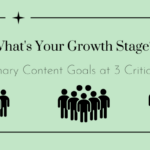You might be surprised to know that even enterprise-scale organizations in technology struggle with creating high-quality B2B content. Shouldn’t creating content get easier as your business gets larger? After all, enterprises have far more staff and resources on board to get the job done.
The truth is, creating high-quality, technology-rich content is never easy. And even the largest global tech brands such as IBM face massive challenges when it comes to building credibility and thought leadership with solid tech content.
When one IOD client, Microsoft for Startups, had only eight weeks to create dozens of case studies highlighting the advantages of its Founders Hub community, they weren’t sure it was possible, even with all of Microsoft’s in-house resources. And getting up to speed with freelancers would have taken months that they simply didn’t have.
Fortunately, IOD was able to spearhead Microsoft for Startups’ content journey, producing high-quality content in weeks, instead of months. Satisfied IOD clients find that rich technical content resonates with a range of audiences, from the C-suite to the practitioner level, bringing in results like…
- 383% increase in organic traffic in just over 6 months
- Fast time to market with assets that are timely and evergreen
- Powerful, seamless pipeline for ongoing content creation
Plus, partnering with IOD for content creation saves money versus establishing an in-house content operation, boosting ROI even further.
No matter what growth stage your organization is at, the importance of solid tech content cannot be understated. In this post, we’ll look at some of the benefits of tech content, then review specific challenges businesses face when creating that content—at any size.
Beyond the Obvious: Why Create Tech Content?
The most obvious purpose of content is attracting and engaging customers, building relationships, and driving sales. When you connect with people across a broad range of stakeholders, you are more likely to create engagement and retention.
Great content can fuel a coherent and consistent approach:
Generate traffic ⇒ Convert ⇒ Close ⇒ Retain ⇒ Promote
This is the classic understanding of content, and it’s what many marketing professionals might still tell you. But in the technology field, there’s another, more urgent reason for creating content: building authenticity and credibility with the audience we call “tech practitioners.”
Who are tech practitioners? These are the hardworking DevOps, security, IT, and other professionals who are actually using the tools and platforms you’re writing about on a day-to-day basis. They’re highly skilled, mission-critical, busy point people in every organization—and chances are they’re stretched to their limits and looking for tools to make their working lives easier.
Reaching this audience is especially crucial because so many solution purchases are now spearheaded by technical personas within the organization, a process known as bottom-up adoption.
And whatever you do, you can’t run the risk of alienating those technical personas with shallow content that doesn’t provide value. Plus, there are many ways that effective tech content is a worthwhile investment that drives ROI in both the short and long term, helping you…
- Build trust and credibility with authoritative content and thought leadership
- Generate leads, then close sales by educating prospects about your products or services
- Improve SEO, drive traffic, and provide assets to aid salespeople
- Continuously test and tune your messaging
And much more.
So what’s getting in the way? Why are so many businesses struggling to create the content they need? Let’s take a look at some of the main challenges for small, medium, and enterprise-scale businesses.
Stage 1: When You’re Just Starting Out…
At startup scale, there’s a DIY element to just about everything you do. Founders and executives are often hands-on at this stage, passionately creating content to reach not only users but also early investors.
Early on in your business’s growth cycle, content marketing can be a valuable tool to build awareness, generate leads, and fuel growth. Rather than being a “nice to have” afterthought, making tech content creation a regular habit early on can help you gain valuable traction and start growing faster.
Most of your content at this stage should be focused on increasing awareness among prospective users and building your brand as a thought leader in your domain. That means it needs to be high-quality and informative, rather than promotional. It should be aimed at practitioners to attract and support your growing community of true fans, the early adopters who will love your product or service as much as you do and serve as your evangelists on Stack Overflow, on Reddit, at conferences, and with their colleagues.
Be careful not to overreach at this stage. We encountered one highly ambitious new startup whose founders aspired to create the “perfect” blog post—a manifesto that would “conquer the world,” as they put it. They wound up with a very technical, complex article that stretched out to 2,500 words—almost an entire ebook. This monster of an article took a tremendous amount of time, didn’t offer value to prospective customers, and was too technical to be useful for investors. As a result, the piece never returned any value and was a big waste of time and money.
Keeping Your Eye on the Ball
Stay focused on the goals mentioned above. Ask yourself critical questions like, “Is this post going to build awareness among prospective users?” and “Will this explainer video catch the eye of a tech practitioner by demonstrating how to solve an urgent problem?” Allow these questions to guide your content creation, and avoid wasting stretched-thin resources on anything else.
In terms of content types, it may be tempting to go all out and release a variety of formats (there’s nothing like that startup enthusiasm!). But realistically, at this stage you should primarily be producing written content (white papers, one-pagers, and of course regular blog posts), along with perhaps one or two videos per year.
Your primary challenges at this stage of growth include:
- Overwork. With everyone likely filling multiple roles and possibly stretched to the limit, regular content creation can be pushed aside by investor meetings or release dates.
- Talent shortage. Finding writers and video producers with the right technical background and marketing skills to represent your target audience is tough—and not often a top business priority.
- Inconsistency. You may lack the tools and resources to plan and measure content results, and without clear metrics, this may be given a lower priority in your grand scheme of things.
Stage 2: When You’ve Outgrown Your Startup Phase…
At this stage, your business has scaled up to the point where you need a fully centralized marketing team. To reach your key B2B audiences, this team should include product experts.
When it comes to content, medium- and large-sized businesses face all the same issues as startups, along with some unique challenges. As a bigger business, obviously you’ll need to create more content, but simply creating more isn’t enough.
Instead, you need to focus on driving user engagement. This entails reaching out across multiple channels to a wider audience beyond your initial base, including potential customers, current customers, and employees. Content should be informative and engaging, helping cement relationships with these audiences.
Organizations that have grown to this scale will need to start looking beyond primarily written content, explainer videos, and the like. You’ll need to add more creativity, come up with infographics, deepen your social presence through micromessaging, and more.
Your primary challenges at this stage of growth include:
- Staying current. You need to keep up with the rapid pace of change in your field, with an ear to the ground to pivot quickly and respond to trends.
- Regularity. Producing high-quality content on a regular basis is a challenge at any size, but it’s especially important at this stage since you’re likely to go head-to-head with bigger and better-resourced vendors.
- Standing out. Besides high quality, your content needs to reflect your values and key differentiators to help you stand out in the very crowded midsize B2B vendor market.
Stage 3: If You’re Operating at Enterprise Scale…
Content at this stage faces the challenge of educating, informing, and inspiring a very wide range of audiences—from practitioners (proving you haven’t lost touch) to the C-suite (proving that you’re grounded in business realities).
Your primary challenges at this stage of growth include:
- Multiple audiences. As your user base grows, you need to meet the needs and interests of a range of stakeholder audiences through a variety of channels.
- Measurability. You’ll have to adopt new procedures for tracking and iterating to achieve ROI for your content marketing efforts and for isolating campaign impact.
- Depth and relevance. You need to engage the tech practitioner audience with rich, deep-tech content to foster product-led growth and bottom-up adoption.
Your content must continue to meet all of the challenges faced by smaller businesses—along with a number of unique complexities. For instance, to reach multiple audiences through a variety of channels, you need reliable, accurate content with a solid grounding in today’s technology. This ensures that you’re taken seriously, building trust in your brand and positioning you front and center as a knowledge resource for technical practitioners. Brand awareness is key at this scale—as is retaining existing customers. You never want them to feel like you’ve outgrown them or their needs.
Content creation at this stage can be summed up with the word “more.” More quantity, more frequency, and also more variety.
Frequent, regular content helps you both stay relevant and retain an edge over your competitors. Plus, at this size, you face the unique challenge of sculpting and preserving your authentic voice so you don’t get lost as a faceless or characterless business as you grow.
Your values matter more than ever, and your content needs to ensure that these shine through.
At this scale, you also need the widest possible variety of content. Your written content may be more complex and sophisticated, for instance, large surveys or industry reports. Plus, you will have to focus on building demand-generation forces through the hyperautomation of emails and social media (such as with nurturing email campaigns). All of which takes tremendous creativity and a vast amount of content.
The Outsourcing Alternative
For most enterprises, whether they’re veteran IT vendors, born-in-cloud vendors, or SaaS giants (click here to find out which of these categories most closely matches your organization), it’s almost impossible to accomplish all of this in-house.
Recognizing this complexity, many enterprise-scale businesses make the wise decision to look outside their shop to outsource all or part of their content creation via freelancers or marketing agencies.
Freelancers
This is probably the first option that comes to mind. Freelance talent gives you on-demand access to professionals who have the skill sets you need. But not every freelancer is right for every task; some may be cloud security experts, others in DevOps or fintech, and so on. So you’ll need at least a few, and finding great freelancers isn’t always easy.
Marketing Agencies
A marketing agency will offer consulting services when it comes to content strategy, bundled with creative services such as writing and video production. But few marketing agencies have the deep-tech experience you need to create content that goes beyond the superficial and resonates with your tech practitioner audience.
A Third Path: IOD
IOD is different. We’ve grown up with cloud technologies. We’re on the ground, right beside you at AWS re:Invent, KubeCon, and other shows because tech is our lifeblood and we wouldn’t have it any other way. Our enterprise clients such as Microsoft, Check Point, and Zoho are tech vendors who need deep-tech content—from explainer videos to webinar demos to white papers. We work hand in hand with their executive, marketing, and tech teams to make content creation hassle-free.
1-2-3: Get Ready To Grow
For B2B marketers, creating rich tech content is a central part of your mission, no matter what size your business has reached. Content is a cost-effective marketing investment that delivers both immediate and long-term results.
Here are a few key content-creation guidelines, based on our extensive experience with businesses of all sizes, you should keep in mind as you scale and grow:
-
- Align goals with your growth stage. Content planning should be an intrinsic part of your company’s strategic decision-making.
- Plan for success. Create a three-month content calendar and make it a top priority across your entire organization. Publishing regularly will help keep your message in front of your crucial tech practitioner audience. But a content calendar also helps you ensure that you share a balance of content—some timely and some evergreen—in a range of formats.
- Establish clear procedures. Content creation can be a headache if you do it differently every single time. By creating procedures, you can ensure consistency and efficiency to take the hassle out of it.
- Track your results. As in other areas of your business, determining ROI is impossible without clear metrics and KPIs. Turn each of your goals into something you can track, measure, iterate, and improve as you grow.
Some of these guidelines may seem simpler when your organization is small, with only a handful or several dozen customers. Creating a centralized, coherent, and consistent content strategy generally becomes more challenging as your customer base increases into the hundreds or thousands.
For example, Iguazio, a growing MLOps solution, sought to reach practitioners with high-quality technical content. They figured their R&D team was up to the task since they knew the product. But they quickly became overwhelmed with the challenge of regularly producing content on top of their usual responsibilities. And their marketing team didn’t know the technical ins and outs enough to satisfy technical-minded readers.
Your capabilities when it comes to content creation might not scale with you. Larger businesses usually need to reach more people, including new audiences, to continue achieving their desired pace of growth.
To help you meet the biggest challenges of engaging your audiences and driving business at every stage, we’ve created this new ebook with a lot more helpful information…






